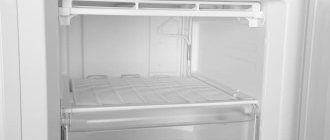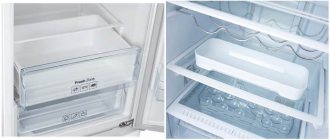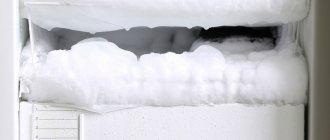As the refrigerator operates, frost forms, which over time turns into ice build-up. And ice increases the load on the compressor, which causes malfunctions. Therefore, it is important to perform timely maintenance of equipment to prevent it from breaking down. How often you need to defrost your refrigerator and how to do it correctly can be found in our review.
How often and correctly should you defrost the refrigerator?
Reasons for the formation of ice on the walls of the refrigerator
The precursor to frost and ice is condensation, which falls on the surface and freezes. Problems arise due to the following reasons:
- Equipment doors remain open for a long time.
- Wear of the sealing rubbers leads to a loose fit to the body.
- Placing hot foods in the refrigerator.
- Storing liquids in open containers.
- Low temperature values on the regulator.
Ice also appears on the walls due to technical faults. If the solenoid valve, which is responsible for regulating the cooling, fails. Problems can be caused by blockage in the capillary pipeline, breakdown of the defrost sensor and compressor overload.
Important!
The appearance of ice is especially dangerous for modern units with a drip system. Condensation appears on the walls regularly, but there should be no ice.
Why do you need to defrost your refrigerator?
To keep your appliances clean, you need to defrost them regularly. The presence of ice in the refrigerator compartment increases the humidity level. As a result, pathogenic microorganisms may appear. In addition, ice build-up reduces the volume of internal compartments. This is why you need to defrost your refrigerator systematically.
There are the following reasons for defrosting equipment:
- Hygienic. High levels of humidity appear due to accumulations of ice and condensation. As a result, an environment favorable for bacteria is formed. Defrosting the unit is an opportunity to check all products and eliminate contamination.
- Practical. Frost formations complicate the operation of the device and reduce the volume of the chambers.
- Technical. When it freezes, the temperature control system begins to malfunction. If there is heavy ice, the compressor receives incorrect data.
Important!
Spoiled food should be disposed of promptly, as it is quickly absorbed into the surface of the refrigerator. To neutralize it, you need professional products that do not contain dangerous components.
Keep your refrigerator clean
What is it for?
Defrosting is necessary for at least three reasons:
Reason number 1 – hygiene . High humidity, which is observed in the chamber due to accumulated condensation and ice, serves as an excellent environment for the spread of bacteria and mold. In addition, defrosting will allow you to clean the chambers, remove dirt and conduct a complete audit of the contents.
Reason #2 – practical . A large layer of frost makes the operation of the unit uncomfortable. The capacity of the chambers decreases, access to shelves and compartments worsens, and the doors do not close/open properly.
Reason No. 3 – technical . In a frozen refrigerator, the temperature control system begins to work incorrectly. When there is extensive ice, the thermoelements become frozen into the ice and send incorrect readings to the compressor. As a result, the compressor operates at full capacity and practically does not turn off, which leads to increased energy consumption and rapid wear of the part. The other extreme is that the compressor turns on much less often, and the temperature in the chamber rises.
How often should you defrost the refrigerator?
To find out how often you need to defrost your refrigerator, it is important to decide on the model. Modern models are equipped with the following types of defrosting:
- No Frost, which translates to no ice. The system operates a fan that distributes the cold throughout the chamber.
- Drip system with built-in evaporator.
- Manual defrost.
- Automated system.
Drip system
Many inexpensive models are equipped with a drip mechanism. The device thaws and freezes at regular intervals. The compressor also starts and stops periodically. An evaporator is placed on the rear surface, on which ice accumulates. After the compressor is turned off, the temperature increases and the condensate drains into the pan. After this, the compressor starts working. Models with a drip system have special sensors that signal the need for defrosting.
If there are regular power failures, defrosting is recommended every four months. When turning off the refrigerator, you need to find a drainage hole on the front panel, under which you need to place a container to drain the liquid.
No frost system
The No Frost design includes an evaporator and high-power fans. These mechanisms provide automatic defrosting without the formation of ice and frost. The equipment does not require complex maintenance. The optimum temperature is maintained inside the system and uniform cooling occurs. The system protects the walls from freezing. Cold currents contain moisture that thickens. The liquid on the evaporator turns into frost, which flows into the pan when heated. As a result, no ice remains on the walls. Experts recommend defrosting your No Frost refrigerator once a year. How long it takes to defrost the equipment depends on the system and the amount of ice.
Manual defrost
This method is simple and is used for devices that do not have know-frost technology and drip mechanisms. To defrost, simply turn off the equipment and place containers into which the liquid will drain. Such units require more time to defrost. Defrosting occurs as ice accumulates.
Manual defrost
Auto defrost system
Expensive models have an automated defrosting system. Users do not need to monitor the frequency of defrosting, since the entire process is carried out automatically.
Useful tips
- After washing, do not turn on the refrigerator immediately, but after 15 minutes, when the surfaces are completely dry.
- Do not try to chip off ice build-up yourself or speed up defrosting with a hairdryer - it is better to wait for it to thaw on its own.
- In extreme heat, it is better not to defrost the refrigerator, so as not to damage it with a sudden temperature change.
- Do not use hard brushes or abrasives for washing - they may damage the coating of the device.
- Do not leave the No Frost refrigerator unplugged for less than 2 hours - this will overload the compressor.
All refrigerators require not only periodic defrosting, but also regular maintenance. Wipe down shelves and walls weekly, immediately clean up spills and wipe away stains to prevent unpleasant odors and the spread of germs.
Don't forget to check out how to defrost your Samsung No-Frost refrigerator.
How often do you defrost your refrigerator?
Once a yearMore often
How to defrost a refrigerator correctly
Almost all models of refrigeration equipment have identical defrosting rules.
Preparing the refrigerator
Preparatory measures are carried out in advance:
- The device is disconnected from the network. To provide access to the rear wall, the unit moves away from the walls.
- All food must be removed from the refrigerator. All stale and expired food should be thrown away.
- Then you need to remove and remove shelves, grids, drawers and containers. They must be washed thoroughly in soapy water.
- It is necessary to prepare containers for melt water, and put rags on the floor.
- The door must be left open for several hours to allow the ice to melt.
Before cleaning, it is important to prepare detergents, napkins, sponges, gloves and rags for wiping.
All products need to be removed
Sequencing
The defrosting process cleans and washes the equipment. To do this you need to do the following:
- While the unit is defrosting, you can remove small debris. Washing begins after thawing.
- The back wall is cleaned of dust using a vacuum cleaner or a dry brush.
- For washing, you need to prepare a special solution. To remove unpleasant odors, use two tablespoons of soda per 0.5 liters of water or use a solution with vinegar.
- Use the solution to wipe all surfaces in the chambers. The far corners must be processed.
- Ventilation holes and drainage holes are cleaned using cotton swabs. Additionally, a syringe or rubber bulb is used. External surfaces are wiped with the same composition.
- The rubber seals are treated with a brush.
- Then you need to wash all the removed containers and shelves.
- After this, all surfaces are washed with water and wiped with dry cloths.
After cleaning, all shelves and drawers are put back in place. It is not necessary to defrost all equipment. Modern models provide defrosting of individual compartments. You can start cleaning a specific camera.
To avoid causing damage to the surface, abrasive components should not be used. Sealants are treated with a citric acid solution. Ventilation grilles can be cleaned using cotton pads. The body is wiped with a sponge dipped in soapy water.
Defrost duration
The duration of the procedure depends on the layer of accumulated ice. On average, defrosting takes 3-4 hours. If the condition is neglected, it may take up to a day. The system stops working and it will take more time to restore it. After defrosting, the refrigerator can operate without stopping for up to 5 hours.
How long does it take for a refrigerator to defrost?
After washing, the refrigerator does not need to be turned on immediately. This can be done after 15 minutes, after all surfaces have dried. You cannot speed up the defrosting process and try to chip off the ice. It is not recommended to carry out the procedure in extreme heat. The defrosting process may take different durations. This depends on the specific model and degree of freezing.
Do not speed up the defrosting process or try to chip off ice.
Preparing for the defrosting process
The main rule that must be followed when defrosting the refrigerator is not to start work if you have a lot of food and do not have a temporary place for their proper storage.
Do not use a construction or household hair dryer or heaters for this purpose; it is unsafe. Do not apply chemical reagents as they can damage the device.
If rubber seals do not function well, try lubricating them with silicone or vegetable oil.
To avoid compressor breakdown, it is recommended to turn it on after at least 12 hours. Try to open the doors as little as possible in the next 3 hours so that the device has the opportunity to quickly create the desired microclimate.
Do I need to defrost the freezer?
It is important to defrost the freezer. This must be done with the manual defrosting method. It is necessary to do the procedure for units with a drip system. First you need to turn off the unit and create all the conditions for thawing the ice.
If the equipment is equipped with two compressors, it is enough to turn off the freezer. The process will go faster if the door is left open. After defrosting, the equipment needs to reach the required temperature indicators. It may take some time to return to normal operation. To prevent the No Frost refrigerator from breaking, it should be defrosted once a year.
But if ice appears ahead of schedule, the defrosting process can begin immediately.
Do I need to defrost the freezer?
Errors during defrosting
In order for the unit to serve for a long time and maintain its functional characteristics, you do not need to make the following mistakes when defrosting it.
- Defrost in hot weather. This will shorten the lifespan of household appliances due to temperature changes. But if such a need suddenly arises, you need to do this either at night, when the temperature outside the window drops to a minimum, or cool the air in the kitchen using an air conditioner and then start thawing the ice build-up.
- Apply abrasive substances such as washing powder. They can cause oxidation and also damage plastic and rubber parts, leaving scratches.
Scratches and chips inside the refrigerator can negatively affect its operation. Scratches are especially harmful to the internal compartments of refrigeration units. When they appear, mold fungi will get there, multiply, and spoil your food.











